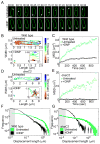The bacterial cytoplasm has glass-like properties and is fluidized by metabolic activity
- PMID: 24361104
- PMCID: PMC3956598
- DOI: 10.1016/j.cell.2013.11.028
The bacterial cytoplasm has glass-like properties and is fluidized by metabolic activity
Abstract
The physical nature of the bacterial cytoplasm is poorly understood even though it determines cytoplasmic dynamics and hence cellular physiology and behavior. Through single-particle tracking of protein filaments, plasmids, storage granules, and foreign particles of different sizes, we find that the bacterial cytoplasm displays properties that are characteristic of glass-forming liquids and changes from liquid-like to solid-like in a component size-dependent fashion. As a result, the motion of cytoplasmic components becomes disproportionally constrained with increasing size. Remarkably, cellular metabolism fluidizes the cytoplasm, allowing larger components to escape their local environment and explore larger regions of the cytoplasm. Consequently, cytoplasmic fluidity and dynamics dramatically change as cells shift between metabolically active and dormant states in response to fluctuating environments. Our findings provide insight into bacterial dormancy and have broad implications to our understanding of bacterial physiology, as the glassy behavior of the cytoplasm impacts all intracellular processes involving large components.
Copyright © 2014 Elsevier Inc. All rights reserved.
Figures






Comment in
-
Cytoplasmic transport: bacteria turn to glass unless kicked.Curr Biol. 2014 Mar 17;24(6):R226-8. doi: 10.1016/j.cub.2014.02.018. Curr Biol. 2014. PMID: 24650906
References
-
- Ausmees N, Kuhn JR, Jacobs-Wagner C. The bacterial cytoskeleton: an intermediate filament-like function in cell shape. Cell. 2003;115:705–713. - PubMed
-
- Berthier L. Dynamic heterogeneity in amorphous materials. Physics. 2011;4:42.
-
- Brangwynne CP, Koenderink GH, MacKintosh FC, Weitz DA. Intracellular transport by active diffusion. Trends Cell Biol. 2009;19:423–427. - PubMed
Publication types
MeSH terms
Grants and funding
LinkOut - more resources
Full Text Sources
Other Literature Sources
Research Materials

